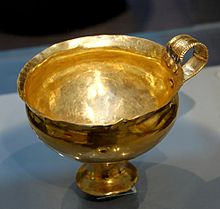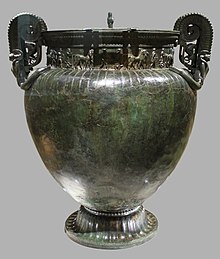Ancient Greece and wine

The influence of wine in ancient Greece helped ancient Greece trade with neighboring countries and regions. Many mannerisms and cultural aspects were associated with wine. It led to great change in Ancient Greece as well.
The peoples of the
The ancient Greeks pioneered new methods of
Origins

Viticulture has existed in Greece since the late Neolithic period, with domestic cultivation becoming widespread by the early Bronze Age. Through trade with ancient Egypt, the Minoan civilization on Crete was introduced to Egyptian winemaking methods, an influence most likely imparted to Mycenaean Greece.[2] The Minoan palaces had their associated vineyards, as Spyridon Marinatos demonstrated in excavations just south of the palace site at Archanes, and the Minoan equivalent of a villa rustica devoted to wine production was unearthed at Kato Zakros in 1961.[3]
In
One of the earliest known
In the Mycenaean period, wine took on greater cultural, religious and economic importance. Records inscribed on tablets in Linear B include details of wine, vineyards and wine merchants, as well as an early allusion to Dionysus, the Greek god of wine. Greeks embedded the arrival of winemaking culture in the mythologies of Dionysus and the cultural hero Aristaeus.[9]
Early remnants of
Colonization and trade

As the Greek city-states established colonies throughout the Mediterranean, the settlers brought grapevines with them and were active in cultivating the wild vines they encountered. Sicily and southern Italy formed some of the earliest colonies, as they were areas already home to an abundance of grapevines. The Greeks called the southern part of the Italian Peninsula Oenotria ("land of vines"). Settlements in Massalia in southern France and along the shores of the Black Sea soon followed, with the expectation that not only would colonial wine production supply domestic needs, but also create trading opportunities to meet the demand of the nearby city-states.[citation needed]
The grape clusters, vines and wine cups that adorn
A
Viticulture and winemaking influences
Ancient Greeks called the cultivated vine hemeris (Greek: ἡμερίς), after their adjective for "tame" (Greek: ἥμερος), differentiating it from its wild form. A massive rootstock was carved into a cult image of the Great Goddess and set up on the coast of Phrygia by the Argonauts.[10] The late Dionysiaca of Nonnus recounts the primitive invention of wine-pressing, credited to Dionysus, and Homer's description of the Shield of Achilles describes that part of its wrought decoration illustrating the grape harvest from a vineyard protectively surrounded by a trench and a fence; the vines stand in rows supported on stakes. He also wrote that Laertes, father of Odysseus, had over 50 grape varieties planted in different parts of his vineyard.[1]
The 4th-century BC Greek writer
While
The Greeks practiced an early form of
Both
As late as the Second Council of Constantinople in 691 AD, exactly three centuries after Theodosius closed the temples, a canon was issued expressly forbidding the cries of "Dionysus!" from the wine treaders, who still were masked;[11] it was recommended that "Kyrie eleison" be substituted.[12]
Greek wine
This section needs additional citations for verification. (August 2021) |
The reputation of a wine depends on the region the wine came from rather than an individual producer or vineyard. In the 4th century BC, the most expensive wine sold in the local agora in Athens was that from Chios, which sold for between a quarter of a drachma and 2 drachma for a chous worth—about 3 liters, or the equivalent of four standard 750 ml wine bottles today.
Like early wine critics, Greek poets would extol the virtues of certain wines and review less favorably those not up to their standards. The wines most frequently cited as being of good quality were those of
The earliest reference to a named wine is from the lyrical poet
. If so, this makes Lemnió the oldest known varietal still in cultivation.The most common style of wine in ancient Greece was sweet and aromatic, though drier wines were also produced. Color ranged from dark, inky black to
Wine was almost always diluted, usually with water (or
Wine in Greek culture
In addition to its significance as a trade commodity, wine also served important
The medicinal use of wine was frequently studied by the Greeks, including
Three bowls do I mix for the temperate: one to health, which they empty first; the second to love and pleasure; the third to sleep. When this bowl is drunk up, wise guests go home. The fourth bowl is ours no longer, but belongs to violence; the fifth to uproar; the sixth to drunken revel; the seventh to black eyes; the eighth is the policeman's; the ninth belongs to biliousness; and the tenth to madness and the hurling of furniture.[18]
See also
References
- ^ ISBN 0-671-68702-6
- ^ ISBN 0-19-860990-6
- ^ Noted in Karl Kerenyi, Dionysos: Archetypal image of indestructible life 1976:56 notes 15, 16.
- Perseus Project.
- ^ The attested Mycenaean Greek Linear B forms of the word are 𐀺𐀜𐀦𐀰, wo-no-qo-so, and 𐀺𐀜𐀦𐀰𐀤, wo-no-qo-so-qe, found respectively, on the KN Ch 1015 and KN Ch 897 tablets.[citation needed]
- ^ Michael Ventris and John Chadwick, Documents in Mycenaean Greek 1959:130
- ^ Iliad XIII.703; Odyssey XIII.32 ("his brace of wine-dark oxen")
- ^ ISBN 0-06-621282-0
- conflict of Lapiths and centaurs.
- ^ Argonautica I.1116-39.
- ^ In representations of Antiquity, the wine-treaders are invariably satyrs and sileni,: "they were indeed the wine-treaders in disguise," Kerenyi observes; in medieval images peasants tread the grapes, their shifts tucked into their belts.
- ^ Noted in Kerenyi 1976:67 and notes.
- ISBN 1-85732-999-6
- ^ Pausanias, Guide for Greece 10.19.4-23.9
- ^ Mycenaean and Late Cycladic Religion and Religious Architecture Archived September 15, 2008, at the Wayback Machine, Dartmouth College
- ^ T.G. Palaima, The Last days of Pylos Polity Archived 2011-05-16 at the Wayback Machine, Université de Liège
- ^ James C. Wright, The Mycenaean feast, American School of Classical Studies, 2004, on Google books
- ^ Eubulus. Semele or Dionysus, fr. 93. preserved in Athenaeus, Deipnosophists 2.37c
External links
- Greek wine history Greek winemakers
- All about Greek wine History
- Evangelos Andreou, It was nice retsina wine.
